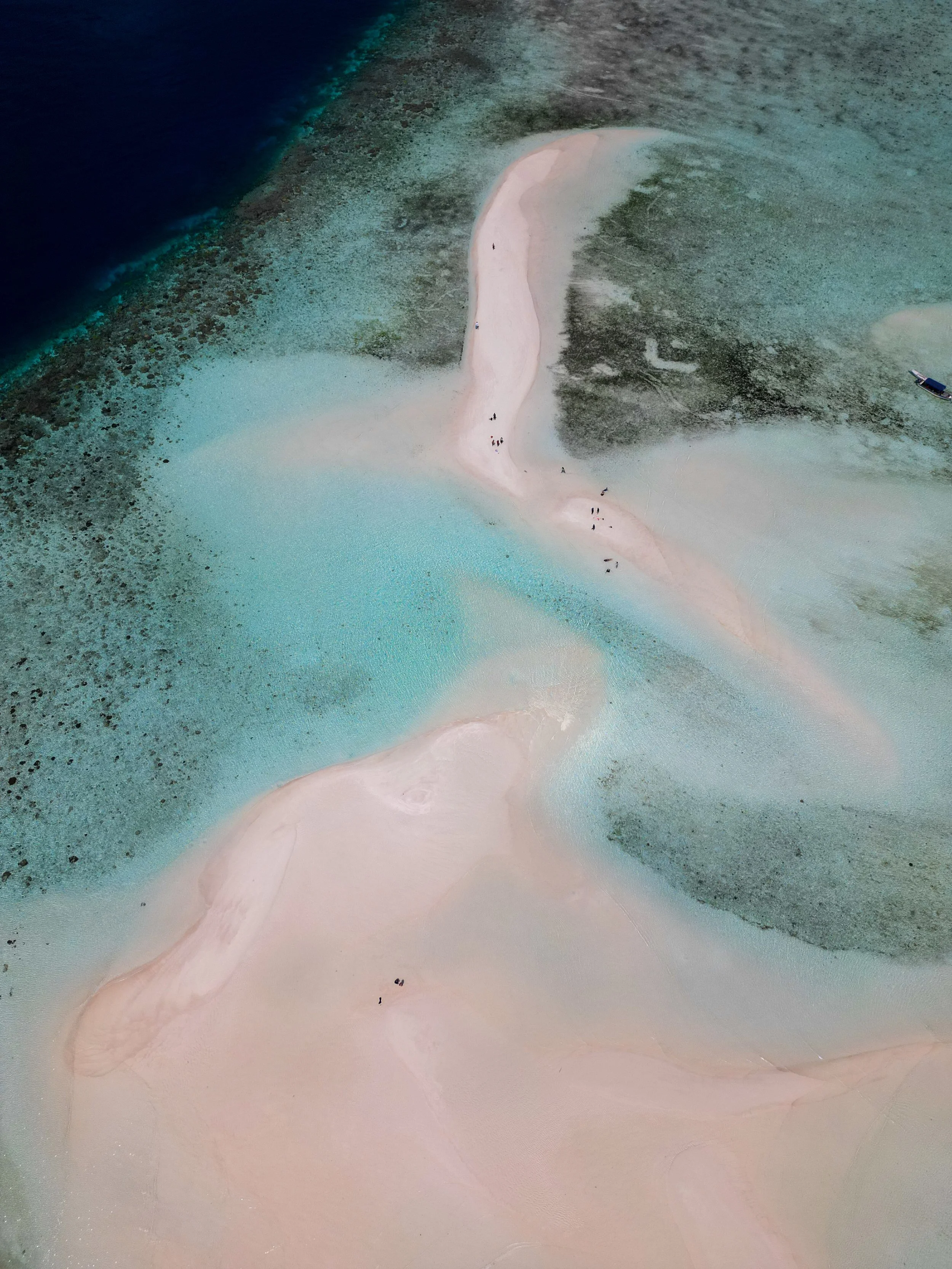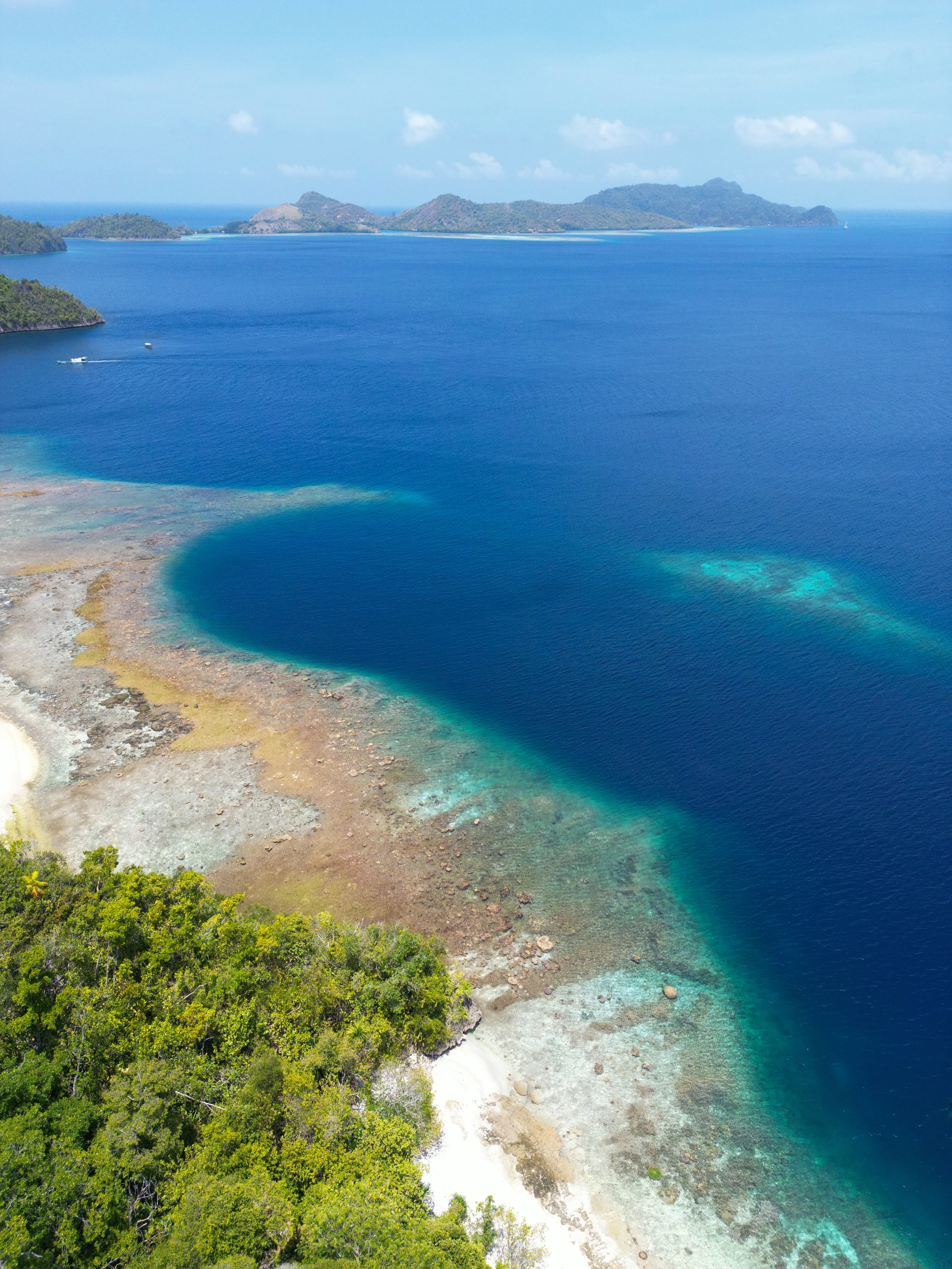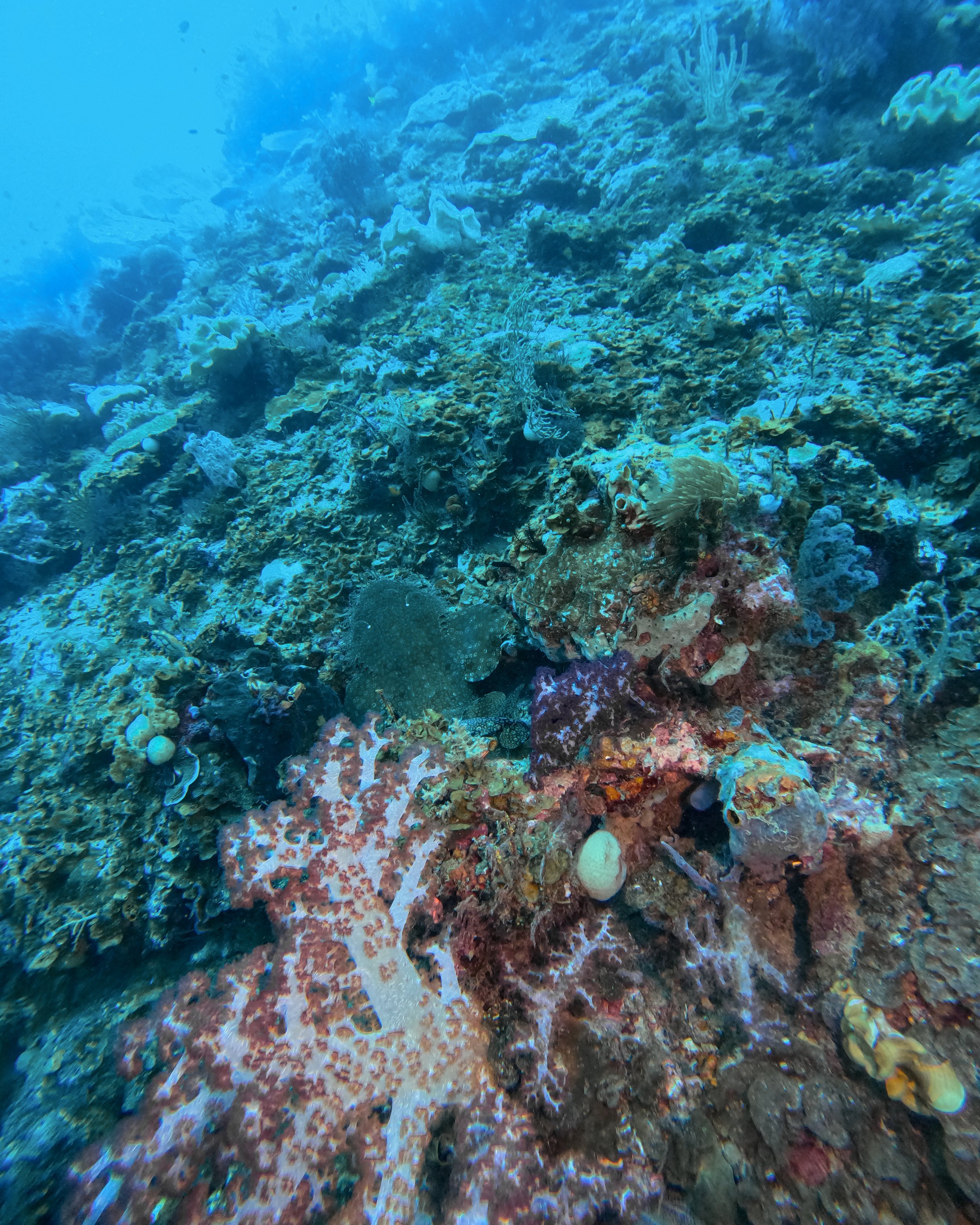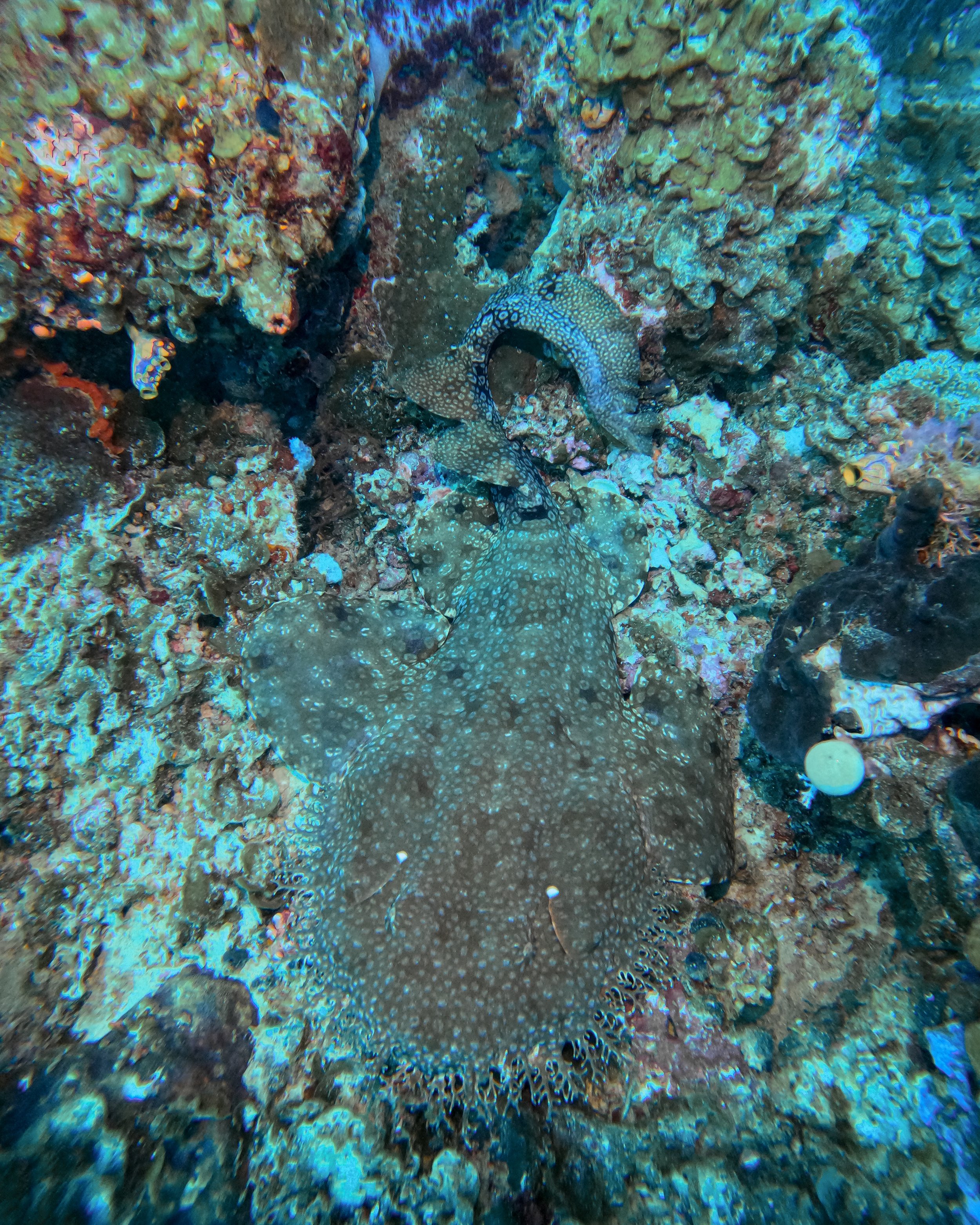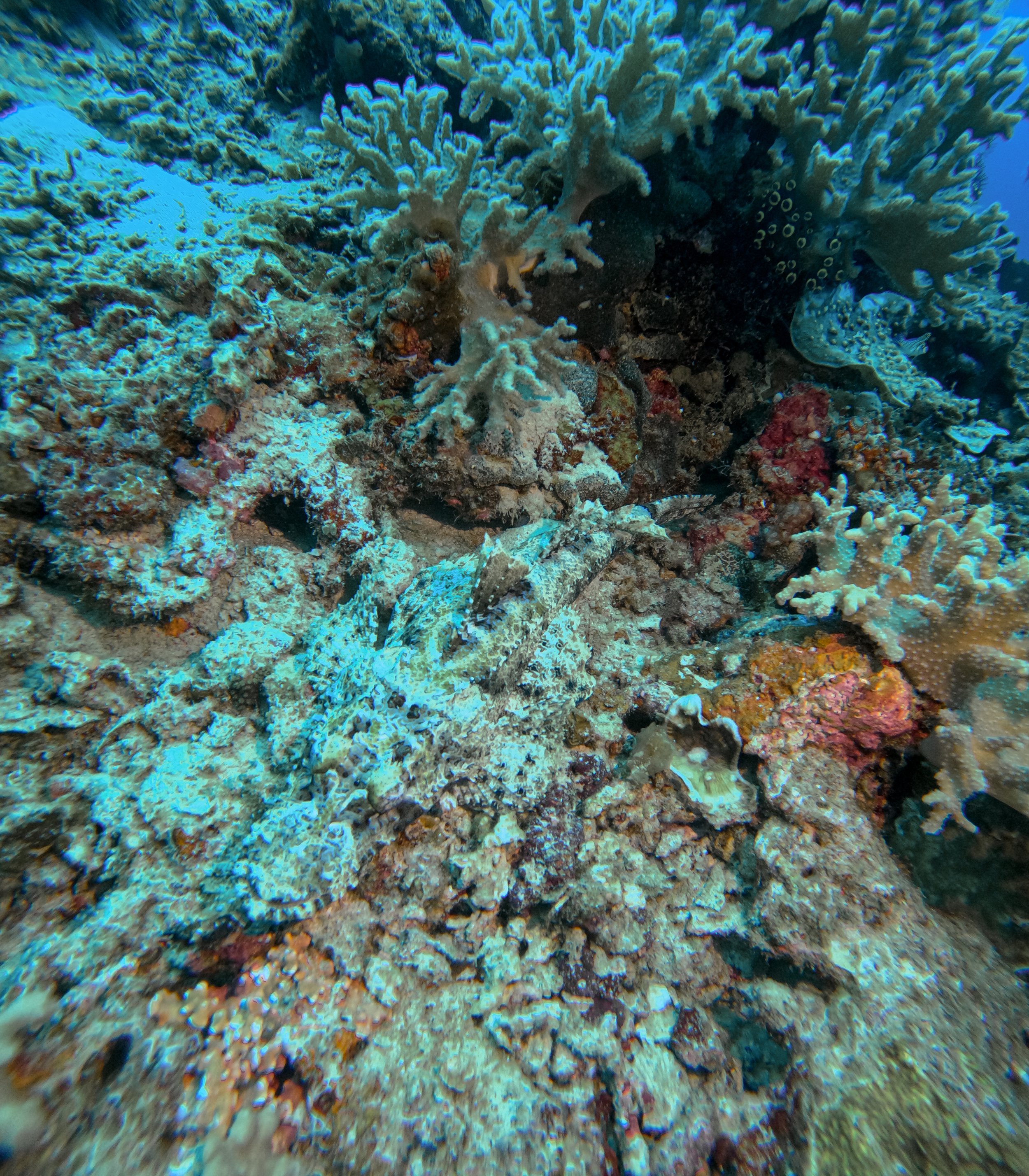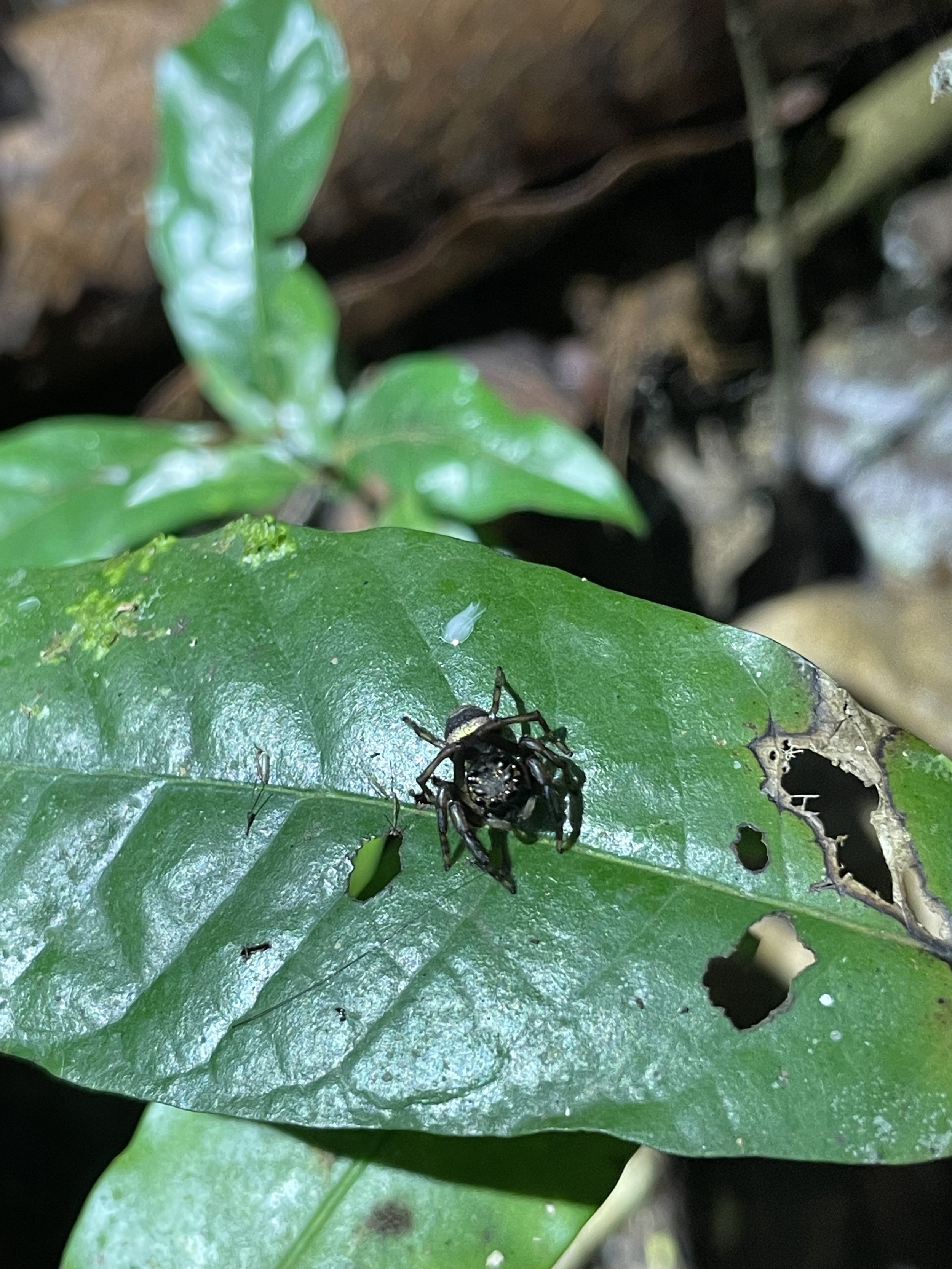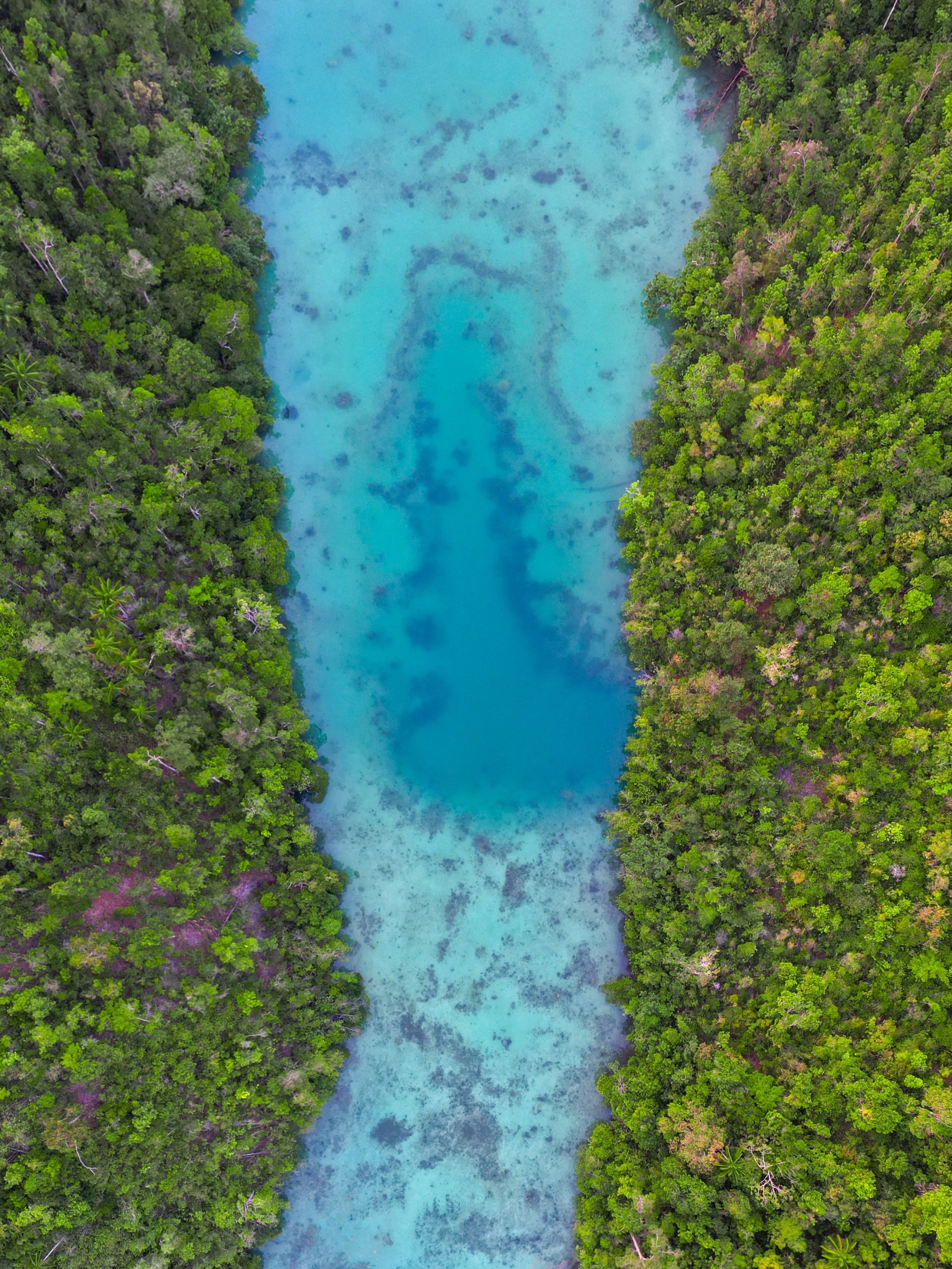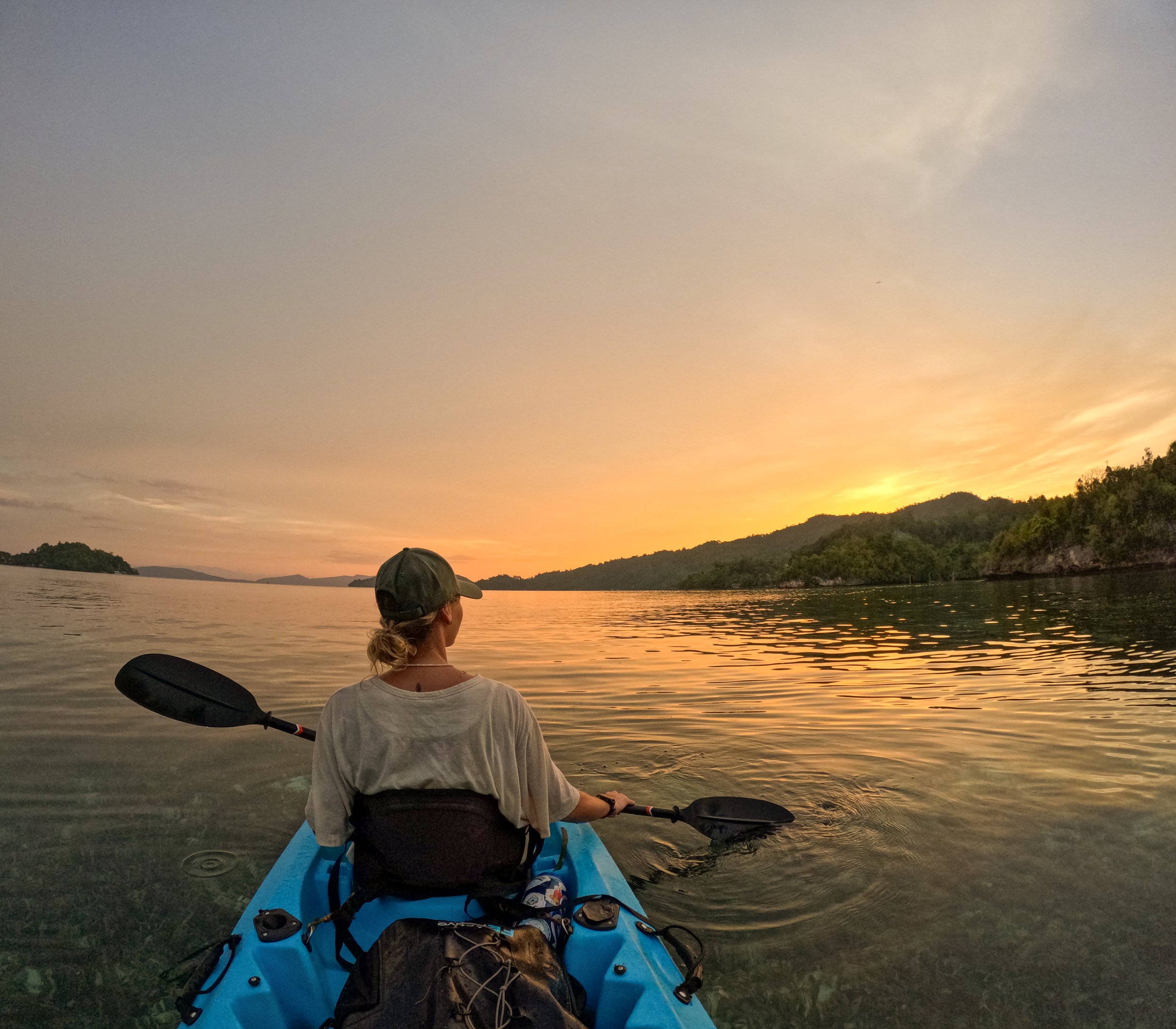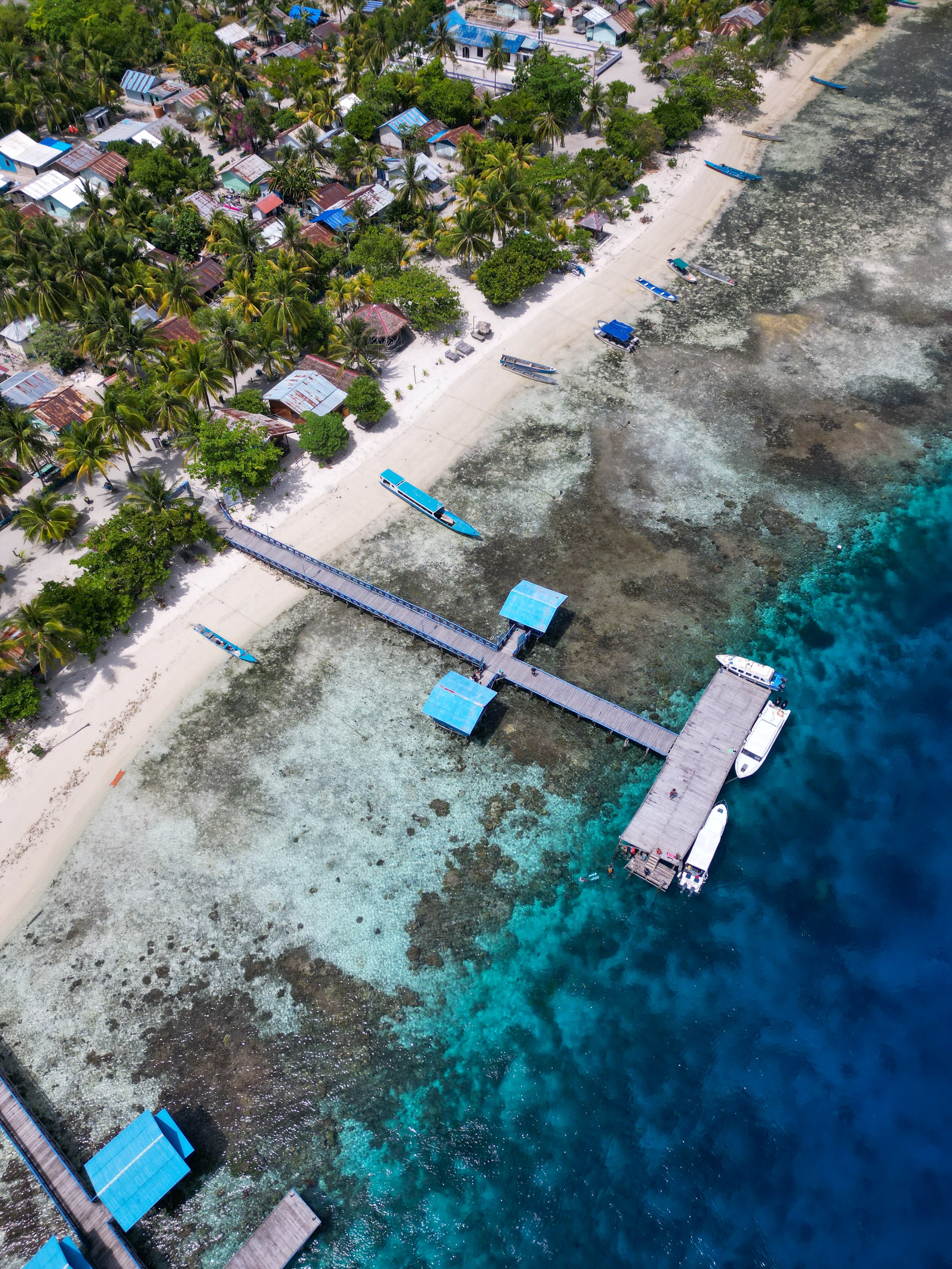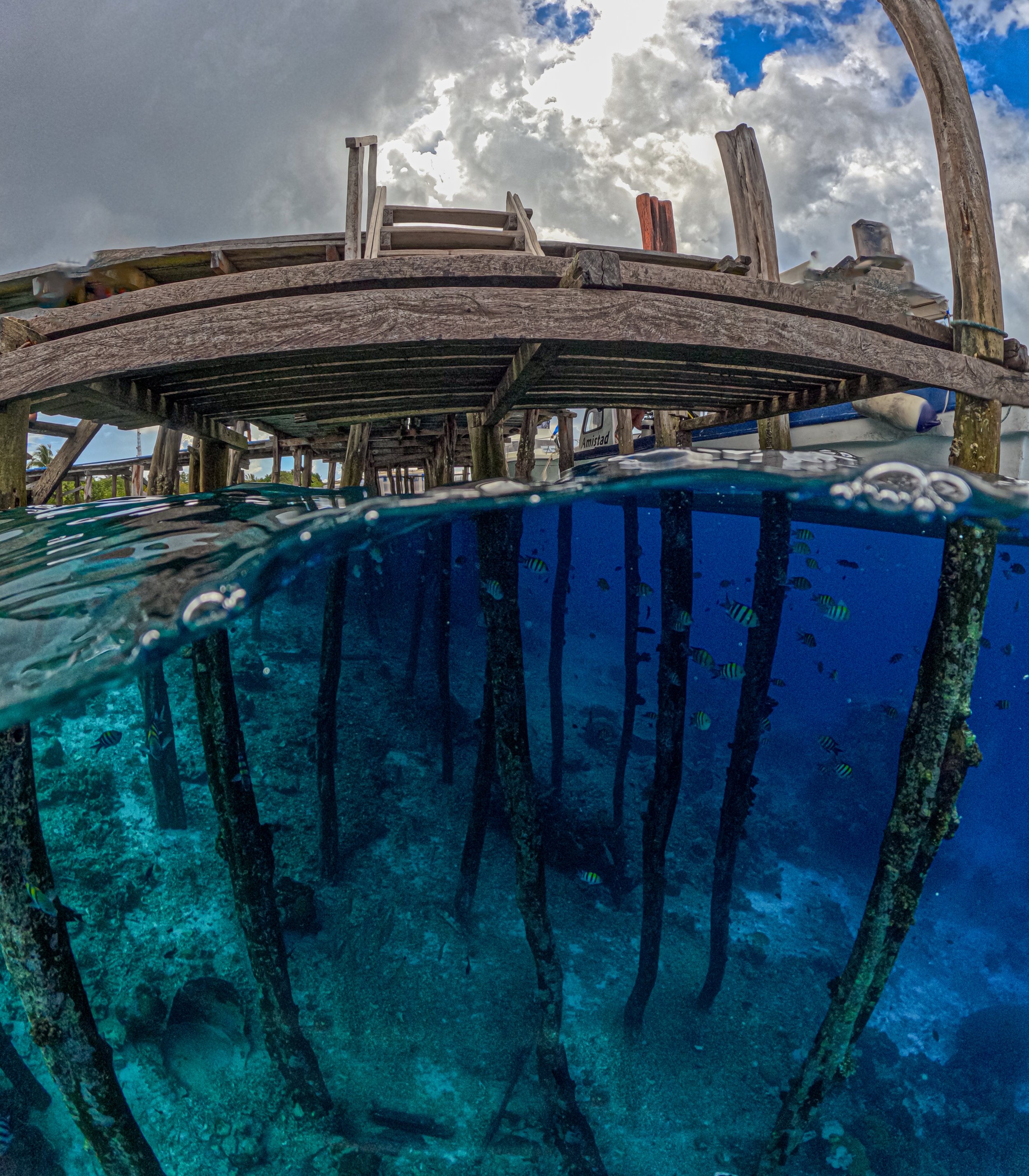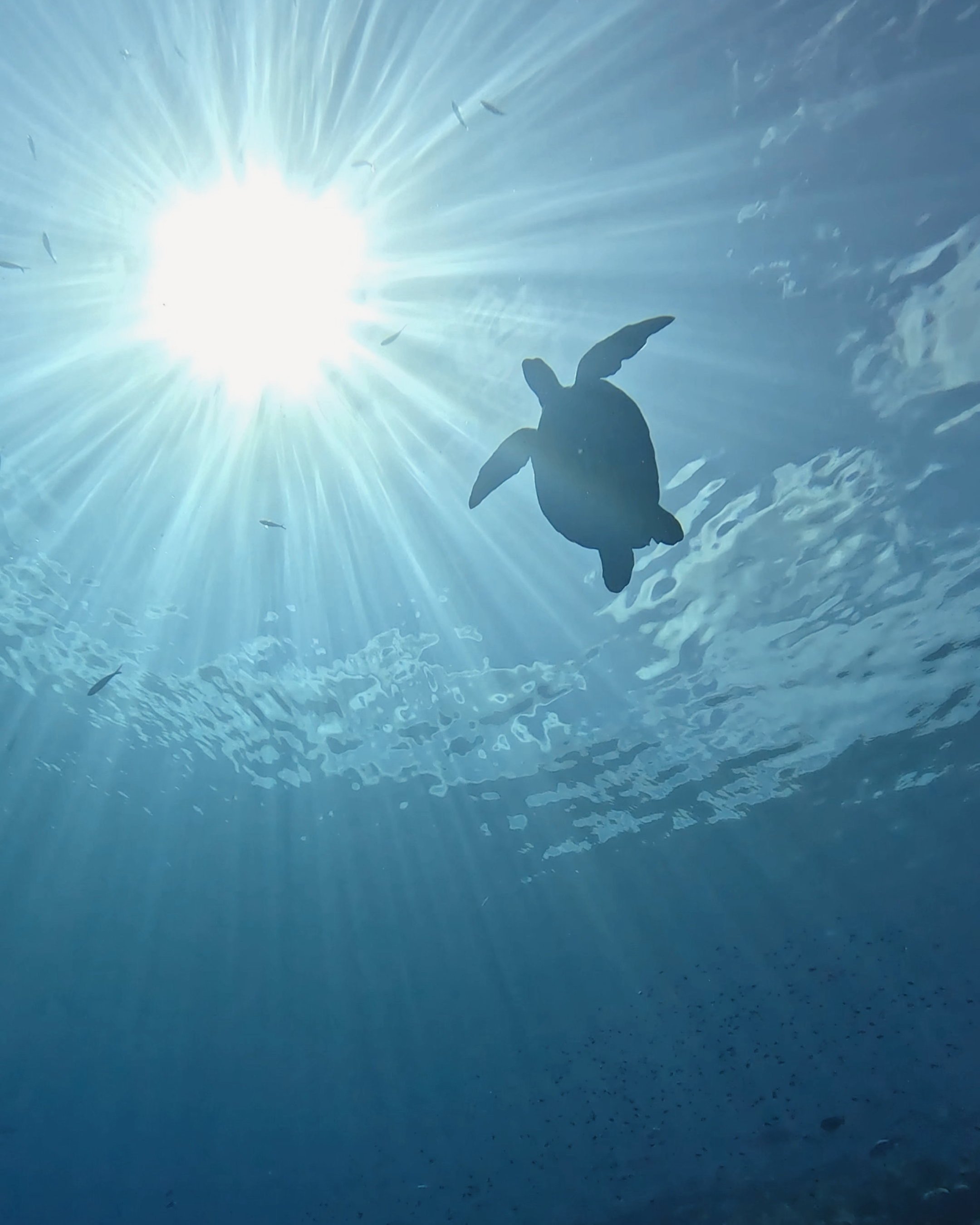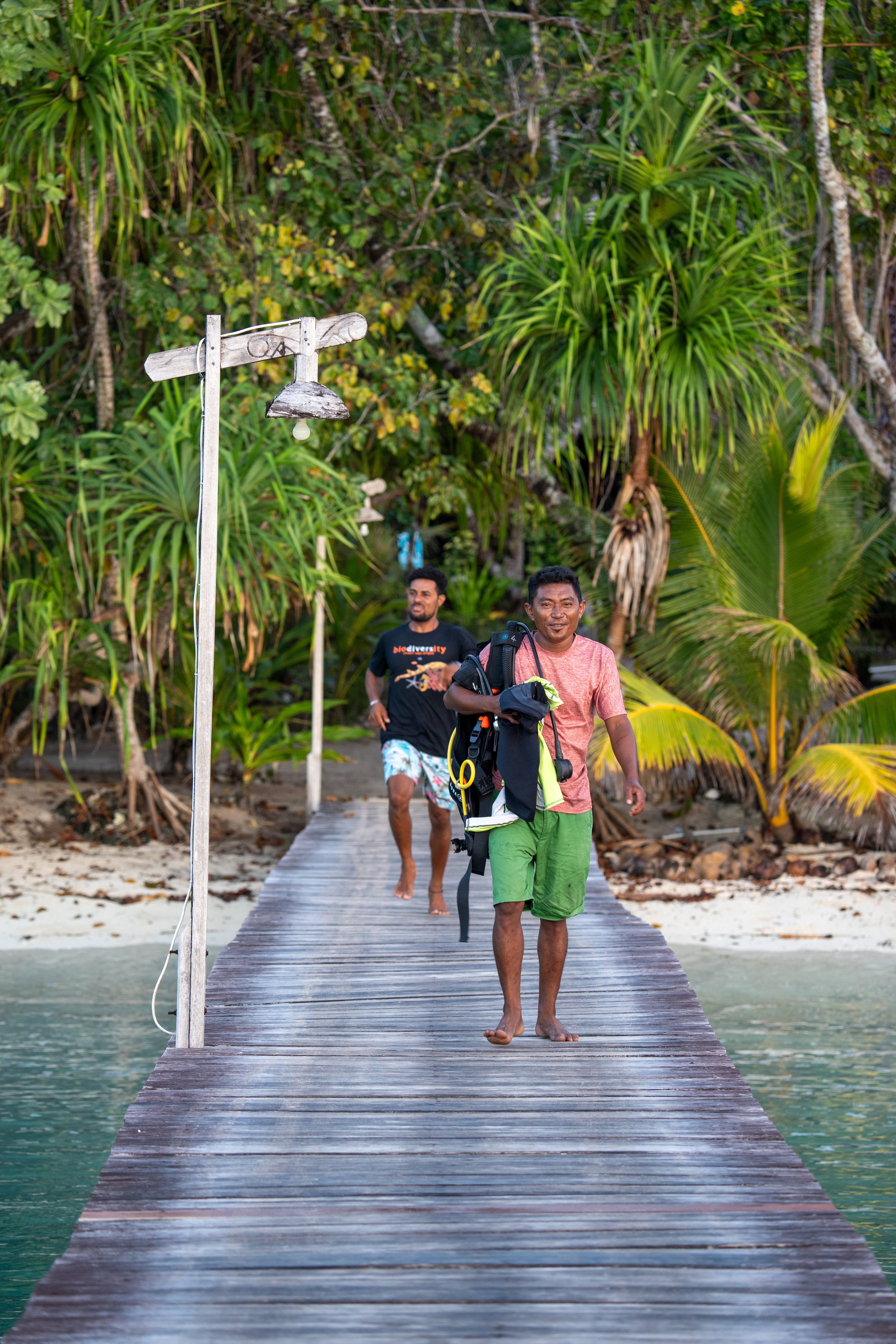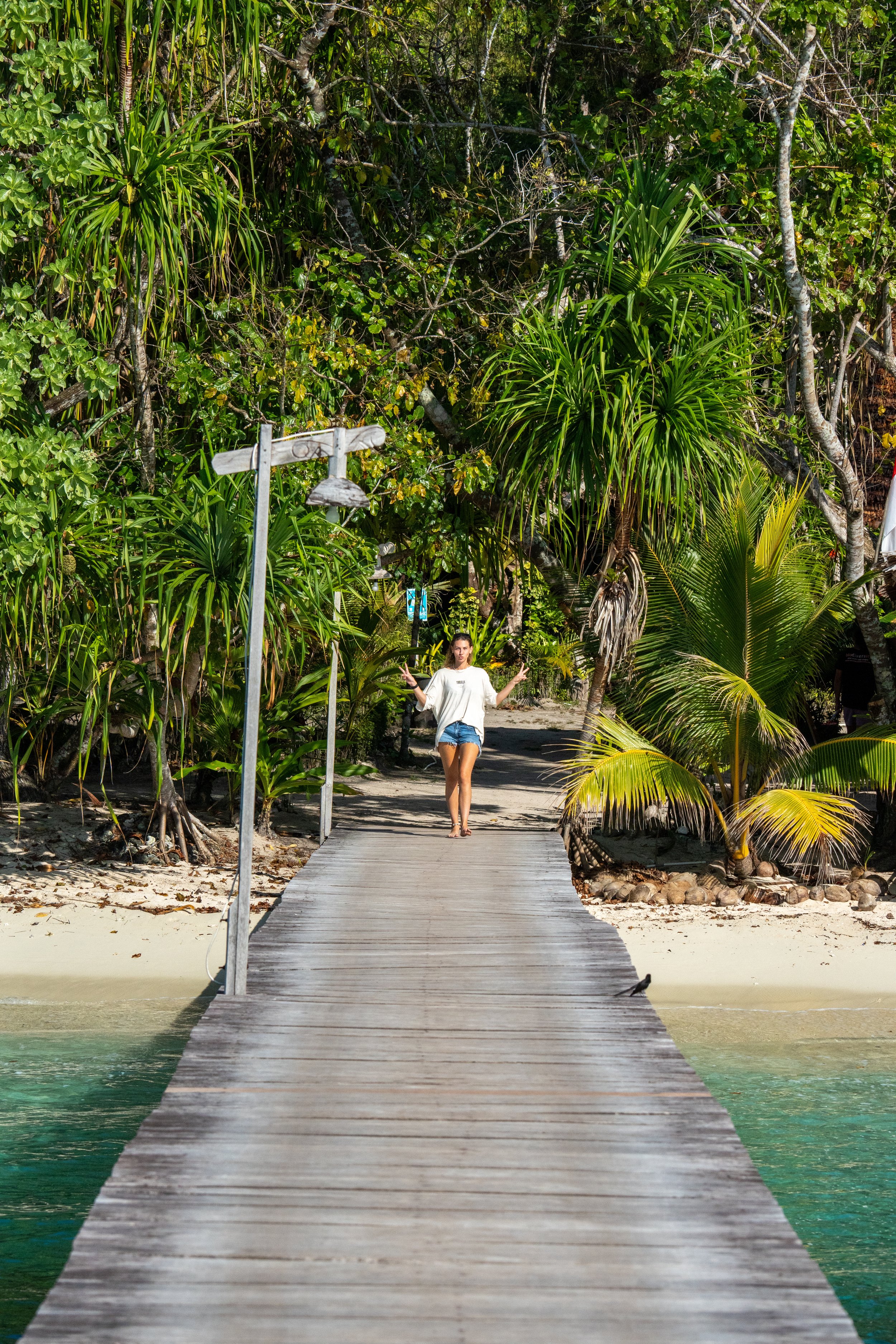Raja Ampat Biodiversity Resort
Raja Blog Part 3
October 9th, 2023
A person I follow on Instagram had stayed here, and I decided it would be a wonderful place in Raja for my diving escapades. I had heard that it was best to go to a reputable diving center due to how remote Raja is, so the gear would be dependable. I was fine with spending the money to go diving in such a delightful place. As Raja is getting more popular, it might be good to go diving in other places, as access to supplies should get easier. Unfortunately, with that comes more tourists, which can be good and bad.
We got checked in and showed to our beautiful room that we would stay at for the next week.
At lunch, everyone sat family-style at two large tables, which is always nice for meeting other people. We met the owners and found out about a snorkeling event at 15:00, which would be at Friwen Wall. We were eager to get into the water and head out for that. Every time I hit the water here, I was blown away at the enormous amounts of coral and fish everywhere. There are multiple species of fish as well. Kat spotted one of my favorite animals, the peacock mantis shrimp, foraging along the bottom near a large cluster of coral. This is one of my favorite creatures due to their epic abilities. They have the fastest strike out of any animal and can create a cavitation bubble that implodes on itself at 5,000 degrees Celsius. They also have the most complex eyes in the animal kingdom and can see in infrared, UV, and color. After getting a video of the mantis shrimp scuttling away, we continued our snorkel.
Another amazing thing about the coral here is that it was filled with one of my favorite types, carnation coral. They are a soft coral type with the most stunning pinks, purples, and oranges of anything on the reef.
As we drifted on, we spotted hundreds of other reef fish, some I had seen in the Maldives, and some were new to me, for which I was getting identification photos. We then finished snorkeling with a beautiful little hawksbill sea turtle.
That evening, the resident cuscus, an amazing animal, greeted us. These bizarre marsupials have zygodactyl feet, meaning they have two thumbs, elliptical eyes, and a prehensile tail. The Waigeo cuscus is endemic to Raja Ampat. We had cocktails at the little beach bar before heading to the dinner tables to chat with everyone before heading off to bed.
October 10th, 2023
I woke up before sunrise to fly my drone and scan the reef tops. I found a beautiful green sea turtle going about its business before I flew the drone back and joined the rest of the guests at the dining area for breakfast.
Since I dive frequently, I would be on a boat with other divers who also had more experience. Our first dive site would be Cape Kri, one of the best sites around due to its steep wall and the schooling fish all over it. Our second dive site was Chicken Reef. The boats leave for the sites at 8:00, so I gathered all my gear for the day, and I brought my drone because we would be visiting a sandbank for the safety stop. Cape Kri is about a 25-minute boat ride from the resort, so in no time, we were all geared up and plunged into the blue abyss. I was immediately struck by the immense volume of fish everywhere. I could see schools of pelagic fish. Barracuda and trevally were everywhere I looked. Black-tip and white-tip reef sharks were on patrol for an easy meal, and millions of colored reef fish were moving around the coral reefs.
Our dive guide pointed at a boulder coral, and on top of it was my lifer crocodile fish! These amazing fish are relatives of scorpion fish. They have amazing camouflaging abilities and wait for unsuspecting prey to come in close, and they hyper-extend their mouths to create a vacuum. They also have a unique eye pattern that is like looking into another galaxy.
I spotted some macro wildlife like flatworms and nudibranchs but did not have my macro lens, so the photos I got were just proof shots for species identification and will not be shared. After 60 minutes, we surfaced and then went for our hour surface interval at a sandbank to get a snack. I launched my drone to get photos and videos of the surrounding area. My favorite thing about being in Indonesia is not only do you get the gorgeous ocean aspects but also the beautiful topography in the background due to how the islands are shaped.
We returned to the boat; this time, we were diving at Chicken Reef, which was close to Cape Kri. So, we quickly got into our gear and jumped overboard. This reef was shallower and had more activity regarding reef fish. I saw so many fish that I had not yet seen since it was only my third time diving in the coral triangle. I stayed shallower so I could be on the top reef, and we came across angel fish, clownfish, and even small Napoleon wrasse, which are always a delight to see since they are an endangered species.
After 60 minutes, I surfaced and got into the boat with everyone else, and we returned to the resort for our lunch at 13:00.
That afternoon, we went for a snorkel. This spot was near an island full of bats, and there was a weird muck on the surface that I avoided because I did not want to swim through guano, as bat guano is suspect at best. We found lovely clownfish, and I got a great shot of me in front of them.
After 50 minutes, we returned to the resort, showered, and hung out for dinner. After dinner, it was another early night because the next day was going to be long as we were visiting two famous places called Melissa’s Garden and Pianemo Viewpoint.
October 11th, 2023
We woke up earlier today as we needed to get on the boat early to reach the farther dive site. The food at Raja Biodiversity Resort has been incredible and tasty. We got our gear together and headed for the boat to check if we had everything before taking a 45-minute boat ride to our first dive location, Melissa's Garden. This is an incredibly famous dive site and is usually ranked in the top 1-5 dive sites on the planet. I was totally exposed to the sun and my skin does not like being on the equator due to the direct contact with the light. I always bring Nomadix towels with me on my travels because they are multifunctional, and I put one over my legs on the boat ride. When we got to the site, there were other boats in the area, so the dive guide checked the current and told us we could get in. I plunged into the water and was immediately met with stunning corals and an explosion of reef fish. We were sitting at about 25 meters and drifting along the sandbed, looking for cool macro wildlife.
I was diving with Kat and a couple of other divers this time. There was one underwater creature that I wanted to find, and that is the Tasseled Wobbegong. When I saw the guide put his fingers below his chin to signify that he found one, I quickly headed over, and there, tucked right under a ledge, was my first ever wobbegong. This is my favorite shark species on the planet, and I finally got to see one in the wild in the most amazing place to dive on the planet. Wobbegongs are known for their beards, which help them hide their contoured shape to ambush unsuspecting prey. They also have a unique pattern that allows them to have almost perfect camouflage amongst the coral and sand. After getting my shots, we headed up into the coral area, which was shallow, but this place had the most incredible coral coverage I have ever seen.
I struggled to keep my regulator in because my mouth was agape. The horned coral patches extended hundreds of meters in every direction and were 100% covered. We came to a giant clam that was the largest I had ever seen. This clam had to be 100 years old and 2 meters long. Its size dwarfed Kat and me.
Afterward, we headed to an island for our surface interval. I launched the drone, but the sun was a little too high, although I still got a few shots of the surrounding area.
When I brought my drone back, I walked around the island, and we discovered about five mangrove monitors that humans most likely had fed because they were extremely interested in our stuff. Monitors or species of the Varanus genus are intelligent animals and can even solve problems. They can recognize their names in captivity and can behave like dogs or cats.
When an hour was up, we headed off for our next dive. This dive site was the Kerou Channel, and it is a beautiful deep wall dive with lots of coral. We found cuttlefish and octopus, along with other gorgeous marine life. We went to about 30 meters and hung around until we needed to ascend so we did not hit deco.
When we surfaced, everyone got dressed to visit one of the more geologically interesting areas of the region, the famous Pianemo viewpoint.
As we entered the lagoon for the viewpoint, we could see these towering limestone structures jutting out of the water, making this such a beautiful place. These limestone cliff clusters throughout the Pacific are truly one of the most breathtaking views you can see when exploring this region. We docked the boat and got off at the platform that the locals made for all the visitors in the area to eat lunch. After lunch, we headed to the top of the viewpoint, and I launched my drone. The area was breathtaking.
We stayed about 30 minutes on the island's top before returning to the boat for our journey back to the resort for a lovely evening with tasty food and drinks and amazing company.
October 12th, 2023
Today was a standard day at the resort with no lengthy trips, so I joined the first two dives of the day. Unfortunately, Kat managed to get an ear infection, so she would sit these dives out. Our first dive site was Moiksen Island. A large school of batfish greeted me, and then I spotted a nice mantis shrimp hidden amongst the coral in the reef.
We saw amazing fish during the dive, and I spotted another Wobbegong hiding under a ledge. I also came across a beautiful, large clam that was almost the same size as the one I saw the previous day.
For our safety stop, we went onto the island, and I launched my drone to get sounding images. This island had a large colony of fruit bats making a ruckus in the trees.
Our next dive site was Firwen Wall, the first site Kat and I snorkeled at when we got to the resort. There are so many beautiful coral boulders around this dive site, and the biodiversity was magical. I love my hard corals, but one of the corals that stood out to me the most here in Raja are the beautiful soft corals and, more specifically, the carnation corals. The corals have a range in every yellow, orange, red, pink, and purple version. They are a breathtaking contrast against the blues, greens, and browns that make up most reef colors when you are at depth.
Our dive group came upon a shelf flattened out and perched underneath, beautifully in full camouflage, which was the smallest Wobbegong I had seen yet. It is exactly how I wanted to find one. These sharks are truly my favorite. The shark was in perfect ambush mode, hiding amongst the corals, blending in for an unsuspecting fish. We left the wobbegong, and I spotted a crocodile fish also waiting in ambush mode, blending amongst the coral.
It was about 55 minutes, so we headed to 5 meters. It is nice that the reef is right there, so you are not twisting your thumbs for the longest three minutes of your life in the open blue, and you can keep diving. I found my other favorite animal, the peacock mantis shrimp. Unfortunately, they can be extremely hard to photograph as they are quick, mischievous crustaceans. We finished the dive and headed back to the resort for lunch.
That evening, Kat and I went off to kayak around the island, specifically to kayak up a river area I spotted with my drone the day before. What is amazing about Raja is that all the rivers are teal blue, adding beauty to the dense dark green jungle surrounding them. We kayaked in, and the hills got higher.
Seeing the abundant bird life moving from tree to tree was so cool. I, for one, love parrots, and seeing the sulfur-crested cockatoos all around us was amazing. On the other hand, being from Australia, Kat sees them as pests because they get into everything everywhere. We got deeper into the area and met other guests from the resort who came via boat. There is a local area for the Red Bird of Paradise here, so we headed up the hill to see if we could find them. Close to the dock, though, was the legendary Alfred Wallace’s hut that he used as his study sites to discover the area.
The famous Charles Darwin is the father of evolution, which is how animals came to be, while Wallace is the father of biogeography, which is where animals came to be found. I find Wallace’s work fascinating because he was the explorer who documented and discovered the southeast Asian and Oceanic islands archipelagos for England. Wallace is also responsible for the Wallace Line, an invisible barrier between Southeast Asia and Oceania. This barrier blocked animals from crossing over. This is why Indonesia is my favorite country in the world; the country is on two continents. The eastern side has Asiatic animals such as elephants, orangutans, monkeys, and tigers, and the Oceania side has Komodo dragons, marsupials, cassowary, and birds of paradise.
After checking out the hut, we headed up the mountain to the top to wait for the Red Bird of Paradise. Unfortunately, none of them showed up that evening, but I was still satisfied with my incredible encounter with them the first week I was in Raja. On our way down, Kat spotted a Peach throat monitor in the tree, which was impressive because this was a monitor species we had not yet seen. Many monitors here look similar but have distinct features that separate them, like the peach throat monitor having a pink throat. Of course, Kat encountered many bugs on the trail as well.
We got back into the kayak and headed downstream. We made our way out of the shadows, and I launched my drone to get photos of this beautiful area. The sun was setting; the sky was exploding with gorgeous colors.
After kayaking back, we had a lovely bonfire with the rest of the guests at the resort before dinner. We all went to bed early because the next day was going to be another long one.
October 13th, 2023
Today, we had to get up early as we were doing three dives starting at 7:00. It was getting close to manta season, so our first stop was going to be the cleaning station the mantas visit when they arrive. We got to the dive site and were briefed on the rules to follow to be around the manta and what to watch for. We descended into a sandy bed area around 8 meters deep, where an extensive line of rocks was used to indicate where the divers could sit and watch from a distance so as not to disturb the mantas’ feeding and cleaning. We sat at the site for around 20 minutes but had no luck with mantas, but I was not too concerned after the amazing experience I had over in Batanta, so we headed to one of the large rocks to explore. Underneath, I spotted a beautiful wobbegong tucked under the ledge.
When spotting wildlife, I tend to need a guide to spot the species I have not seen in the wild first, but then my brain understands what to look for, and I can find them on my own. I took photos of this one, and we moved along with the current to an area with an exceptionally large lettuce coral. At the end of the coral, another ledge housed the largest wobbegong I had ever seen.
I was photographing the wobbegong and noticed one of the other divers and the group signaling they spotted a ray. I responded that I was photographing a wobbegong. You dangle your fingers under your shin, hinting at these beautiful sharks' beards. He motioned again and pointed, and I insisted, no, it is a wobbegong. Then he motioned for me to turn around. I turned, and right behind me was a juvenile manta ray. The wingspan could not be more than 1.8 meters wide. This is officially the 6th manta I have seen during the trip. I have not seen many juveniles, so this was a very cool find.
The manta made a couple of passes to check us out and then floated off into the blue. By this time, it was the end of the dive, and we got back on the boat. Our next dive site was the village island of Arborek. We pulled into the island’s jetty for our first surface interval. We had a quick snack, and I launched my drone to get videos. The island was flat and reminded me of the local islands in the Maldives, where I was currently living.
It was go-time again, so we got onto the boat, and after 5 minutes, headed to the edge of the jetty on the eastern side and dropped under the water to dive with everyone. Immediately, my senses were overloaded as I was looking at another of the most abundant and bountiful reefs I had ever seen, as well as millions of fish and multiple species everywhere. This being a jetty, I was gobsmacked by the biodiversity here. I had heard it was a great spot, but I never imagined it would be like this.
I saw a crocodile fish lying on the sand bed and a scorpion fish tucked on a rock near beautiful coral. I took a moment to spin in a 360 and get a sense of how much was around me.
The current started to pick up, so we headed past the jetty for a unique place where the villagers had collected giant clams and placed them here under the protection of the village; these clams were astronomical in size, like the one I saw in Melissa’s garden the other day.
The high current energy brought forth the largest Napoleon wrasse I have ever seen. They have become my favorites due to their beautiful green and blue patterns. Juveniles are all female, and when they go through a change and become male, they get those gorgeous colors. I love that when they pass you, they always give you a slight turn of their body with a side eye, watching you from a distance. They are unfriendly and critically endangered due to overharvesting for their meat. It is a true treat for any ocean lover to see one this size.
Another large fish species that I did not expect was the biggest bump head parrotfish I have ever seen. This species is the largest herbivorous type of fish, reaching around 1.5 meters in length. What is utterly amazing is the behavior regarding mating and territory from the males. They have large bumps on their head that the males smash together, and they hit each other so hard that the water between their heads explodes, creating concussion waves of sound that can be heard for kilometers around.
However, the current was so strong that my air was getting low, so I headed back toward the docks to get shots of the gorgeous corals attached to the jetty support beams. In Raja, the corals tend to grow everywhere, on anything they can cling to, so many wooden structures have corals growing on them. We exited the water on the jetty and then had our surface interval with lunch.
Our next destination was a boat ride of about 30 minutes onto the back side of Mansuar Island to Sauwandarek Village to dive under their jetty. We jumped into the water and descended onto one of the largest lettuce coral patches I have ever seen. My mind continued to be constantly blown. There were hundreds of snapper gathered on top of it that I would have loved to have gotten close to, but the bottom looked like it was around 40 meters deep. I did not want to go down that far, as I needed to conserve my air since there was so much to see on this dive. We moved to the shallows and saw beautiful schools of fish, but this time, there were turtles all over the place.
An absolute monster of a green sea turtle female, an older one, was sleeping under a coral mound. I had Andrew get near her for size reference. Moving back and forth around the area, we constantly ran across other turtles and more stunning coral reefs with thousands of reef fish around them.
When we finished the dive, I was satisfied that this was my last dive in Raja. I even shed a tear as I saw so much beauty and what a healthy coral reef should look like, which was truly spectacular. We returned to the resort and got ready for dinner and cocktails with everyone.
I had not done a night dive yet and was planning to, but everyone I asked said they were beat after our three dives, so I suggested a night snorkel and found a few takers. We jumped in, and within 30 seconds, I spotted the main creature I was hoping for during a night snorkel: the beautiful epaulet shark or walking shark. These amazing small cat sharks use their pectoral fins to move along the bottom for food.
Sensing my excitement, some others got into the water to join us, so we had about 10 people in the water looking for wildlife. I went under the dock and found a little octopus on a rock. Then, I spied a nurse shark just about a meter long hanging out under a rock.
The other cool animals we found included a crown of thorns, a slipper lobster, blue spotted ray, and a red hermit crab. After seeing seven little sharks, I was happy to give up on the night. I took a shower and headed to bed, exhausted but completely satisfied.
October 14th
The next day, I spent the morning relaxing and birding before starting our journey to Sorong for the night, flew out to Jakarta on my birthday, and then I returned to the Maldives.
Thank you for reading this blog. Raja Ampat is the most beautiful place I have ever seen. I have never seen so much pristine coral in my life. Hence its nickname, The Last Paradise. But with all the things that are beautiful and worth seeing in the world comes human impact. I did see my fair share of plastics and trash, so I hope people and companies continue to reduce the amount of single-use plastics they use. Indonesia is one of the world's top polluters, and a sizable portion of that is due to tourism, so we, as tourists, must try to do better. Indonesia is my favorite place in the world because of what it offers, and I hope everyone reading this blog will get the chance to visit this country. In Raja, I met many extraordinary people who love this place, cherish its beauty, and work hard to provide sustainable tourism to share it. Stay wild, everyone!

















